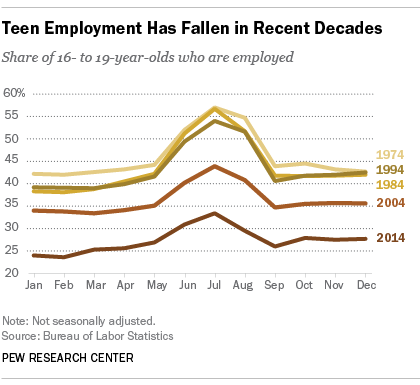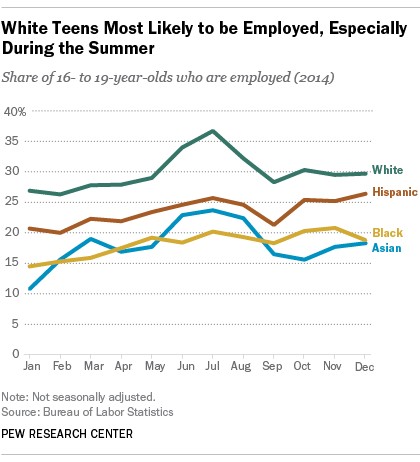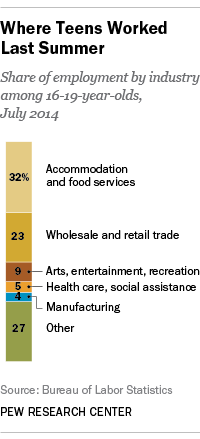
In the 1970s and ’80s, most teens could expect to be working at least part of their summer vacation. But the share of teens working summer jobs has dwindled since the early 1990s; last summer, fewer than a third of teens had a job.
To understand what’s happened to the Great American Summer Job, we looked at the average employment rate for 16- to 19-year-olds for June, July and August (teen employment typically peaks in July of each year). Since 1948, which is as far back as the data go, through subsequent decades, teen summer employment followed a fairly regular pattern: rising during economic good times and falling during and after recessions, but generally fluctuating between 46% (the low, in 1963) and 58% (the peak, in 1978).
That pattern began to change after the 1990-91 recession, when the teen summer employment rate barely rebounded. Teen summer employment again fell sharply after the 2001 recession and again failed to rebound, and fell even more sharply during and after the Great Recession of 2007-09. After bottoming out in 2010 and 2011 at 29.6%, the teen summer employment rate has barely budged – it was 31.3% last summer.
For younger teens, the summer-jobs picture is especially bleak. Last year’s summer employment rate for 16- to 17-year-olds was 20%, less than half its level as recently as 2000. For 18- and 19-year-olds, the summer employment rate last year was 43.6%, still well below the 62.6% average rate in the summer of 2000.

The decline of summer jobs is, in fact, a specific instance of the decline in overall youth employment, a trend that’s also been observed in other advanced economies. Researchers have advanced multiple explanations for why fewer young people are finding jobs: fewer low-skill, entry-level jobs than in decades past; more schools restarting before Labor Day; more students enrolled in high school or college over the summer; more teens doing unpaid community service work as part of their graduation requirements or to burnish their college applications; and more students taking unpaid internships, which the Bureau of Labor Statistics does not consider being employed.

White teens are much more likely to work over the summer than teens of other races and ethnicities. Last year, for example, the summer employment rate for 16- to 19-year-old whites was 34.0%, versus 19.3% for blacks, 23.0% for Asians and 25.0% for Hispanics (who can be of any race). About 1.3 million more teens were employed in July 2014 than in April, a rough gauge of summer jobholding; 1.1 million, or 84.2%, were white.
When teens do get summer jobs, where are they working? Nearly a third (32.2%) of the 5.6 million teens who were employed last July worked in “accommodation and food services” – restaurants, hotels and the like, according to the BLS. About 22.5% worked in wholesale or retail trade; 8.8% worked in the arts/recreation/entertainment industry.
